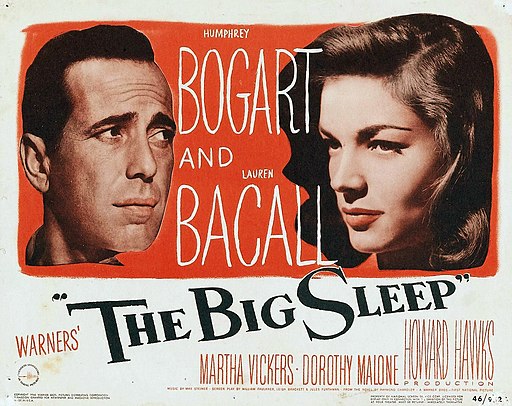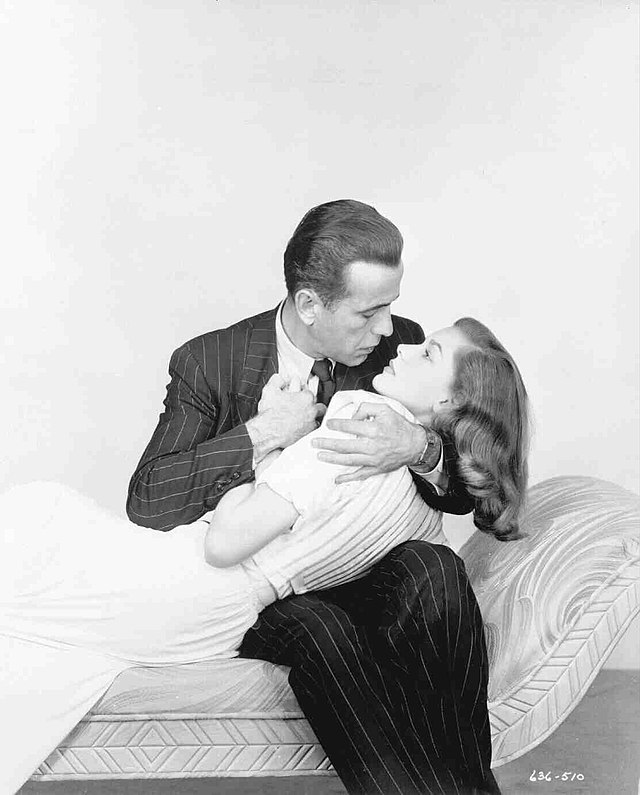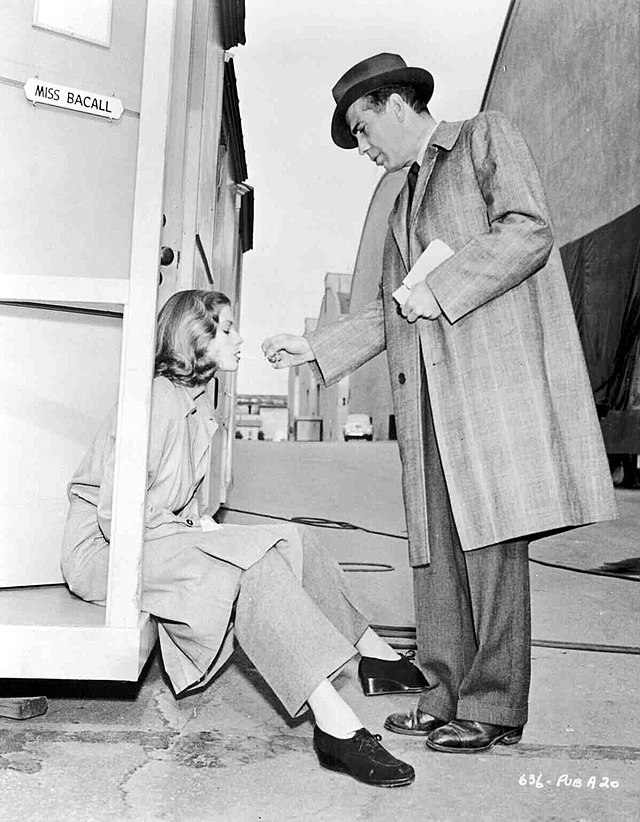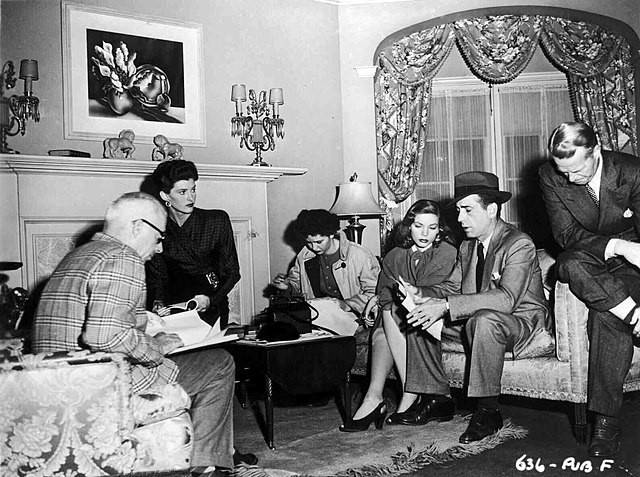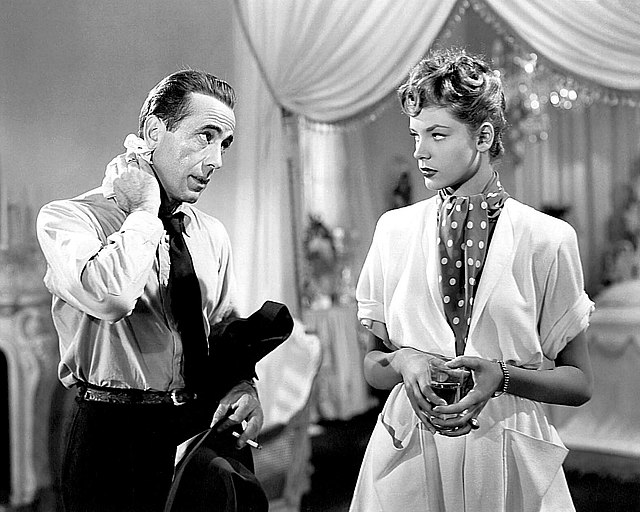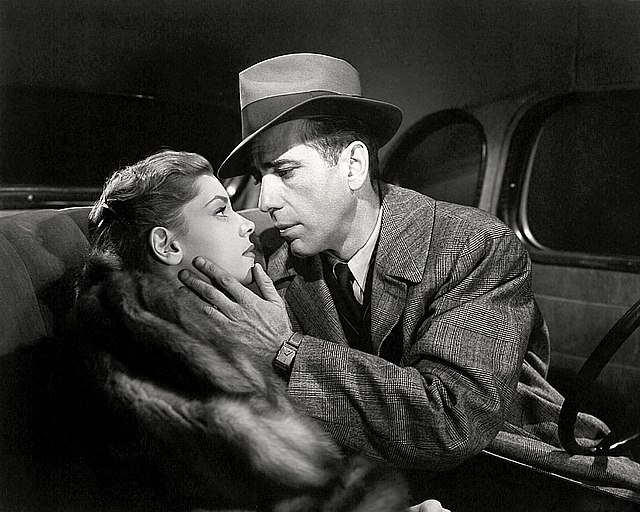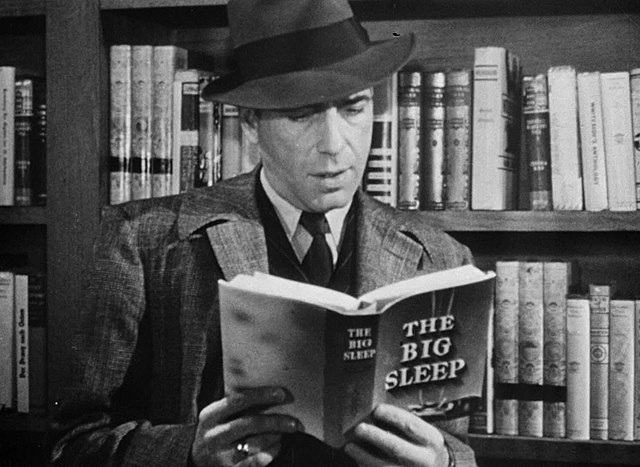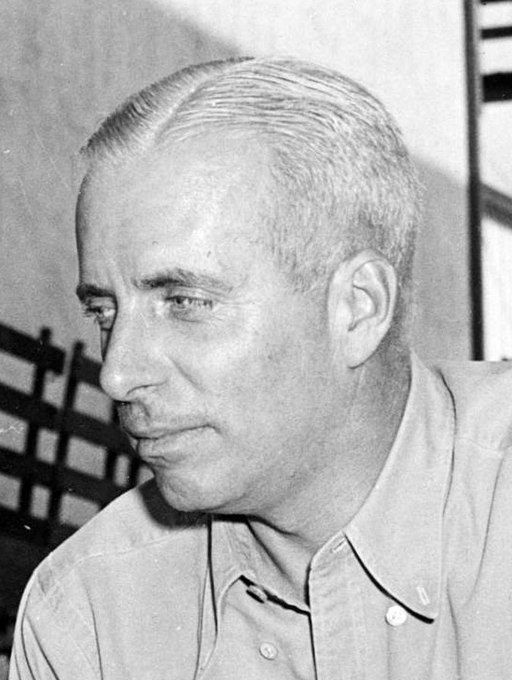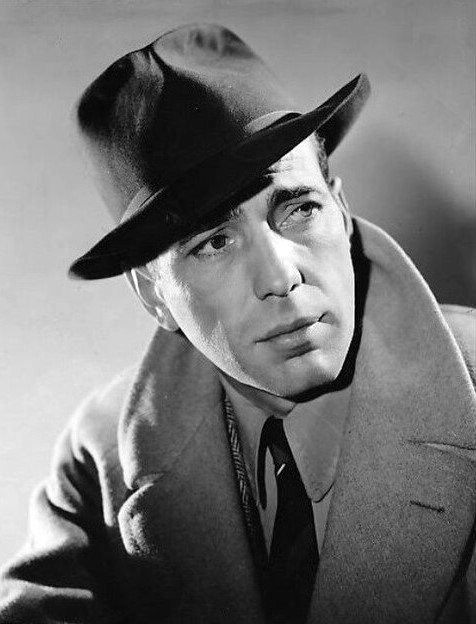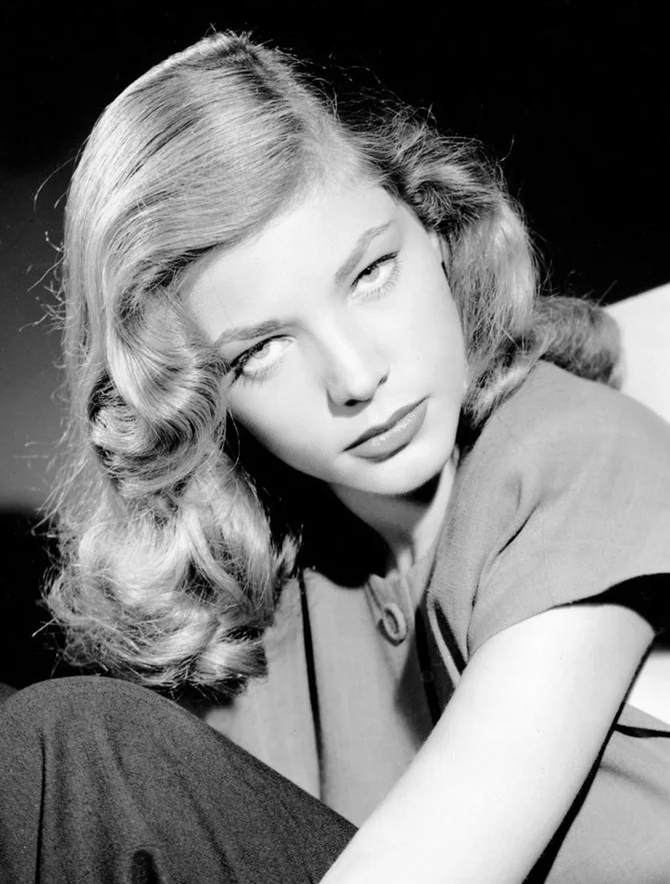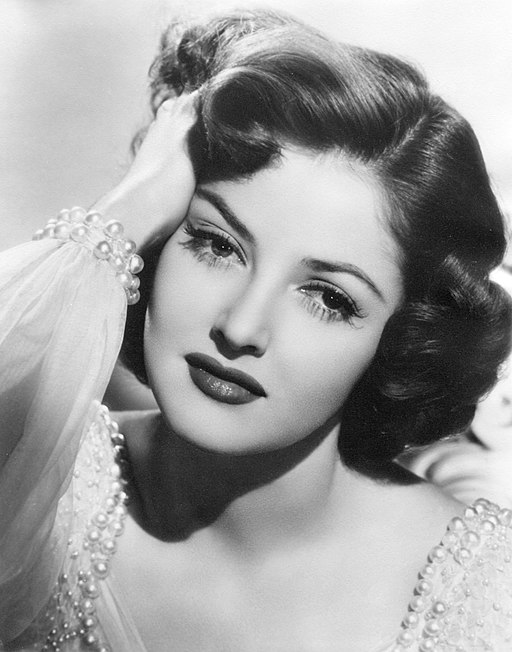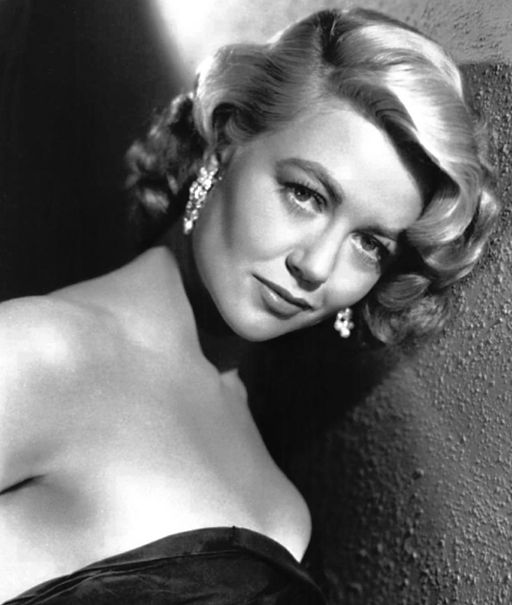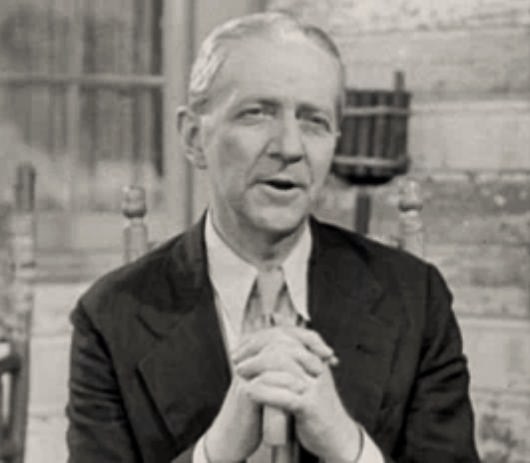The Big Sleep - 1946
back| Released by | Warner Bros. |
| Director | Howard Hawks |
| Producer | Howard Hawks |
| Script | William Faulkner, Leigh Brackett, Jules Furthman (based on the novel |
| Cinematography | Sidney Hickox |
| Music by | Max Steiner |
| Running time | 114 minutes |
| Film budget | $1.6 million |
| Box office sales | $3.5 million |
| Main cast | Humphrey Bogart - Lauren Bacall - John Ridgely - Martha Vickers - Dorothy Malone - Charles Waldron |
The Big Sleep
A Quintessential Film Noir
"The Big Sleep" (1946), directed by Howard Hawks, stars Humphrey Bogart as private detective Philip Marlowe. Hired by General Sternwood to resolve a blackmail issue involving his daughter Carmen, Marlowe uncovers a complex web of murder and corruption.
The film's sharp dialogue, intricate plot, and the palpable chemistry between Bogart and Lauren Bacall's Vivian Rutledge define this quintessential film noir. Its impact on the genre is profound, setting a high standard for narrative complexity and character-driven storytelling, cementing its place as a classic.
Related
The Big Sleep – 1946
Summary
"The Big Sleep" (1946) is a classic film noir directed by Howard Hawks, based on the 1939 novel of the same name by Raymond Chandler. The movie stars Humphrey Bogart as the hard-boiled private detective Philip Marlowe and Lauren Bacall as the mysterious Vivian Sternwood Rutledge.
Plot Overview
The story begins with Philip Marlowe being hired by the wealthy General Sternwood to handle a blackmail case involving his wild youngest daughter, Carmen Sternwood. Arthur Gwynn Geiger, a rare book dealer, is attempting to extort money from the general due to Carmen's gambling debts. As Marlowe delves into the case, he discovers a labyrinthine plot filled with murder, deceit, and corruption.
Geiger's Murder: Marlowe tracks Geiger to his home and witnesses his murder. He finds Carmen Sternwood drugged and semi-conscious at the scene. After taking her home, Marlowe returns to find Geiger’s body missing. This mysterious turn sets off a chain of events that leads Marlowe deeper into the dark underworld of Los Angeles.
Eddie Mars and Vivian Rutledge: Marlowe's investigation brings him into contact with Eddie Mars, a shady casino owner, and Vivian Rutledge, Sternwood's elder daughter. Vivian is linked to the disappearance of her husband, Rusty Regan, adding another layer of complexity to Marlowe's investigation. Despite warnings and threats, Marlowe pushes on, driven by his relentless pursuit of the truth.
Murder and Manipulation: Marlowe uncovers that Joe Brody, a small-time crook, is involved in Geiger’s operation. When Brody is murdered, the case takes a darker turn. Marlowe’s dogged determination leads him to discover that the blackmail and murders are part of a larger, more sinister scheme orchestrated by Eddie Mars, who is manipulating events from the shadows.
The Final Confrontation: The climax sees Marlowe facing off against Eddie Mars. In a tense showdown, Marlowe tricks Mars into thinking his own henchmen will betray him, leading to Mars’s death. Marlowe also solves the mystery of Rusty Regan’s disappearance, uncovering that Carmen Sternwood had killed him in a fit of rage and Vivian covered it up to protect her sister and their family’s reputation.
Themes:
- Corruption and Morality: "The Big Sleep" delves into the corrupt world of 1940s Los Angeles, showcasing how crime and deceit permeate every level of society. Marlowe, despite his flaws, acts as a moral compass, navigating this corrupt landscape with his own code of ethics.
- Complexity and Ambiguity: The plot is notoriously complex, filled with twists, turns, and unresolved questions. This complexity reflects the moral ambiguity of the characters and the world they inhabit, leaving the audience in a state of constant suspense.
- Gender Dynamics: The film explores gender roles and power dynamics, particularly through the characters of Vivian and Carmen Sternwood. Vivian is portrayed as a strong, enigmatic woman who matches Marlowe's wit and resilience, while Carmen's vulnerability and recklessness drive much of the plot's tension.
Character Analysis:
- Philip Marlowe: Bogart’s portrayal of Marlowe is iconic. He is the archetypal private detective, tough yet principled, navigating the murky waters of crime with a mix of cynicism and integrity. His sharp wit and unflappable demeanor make him a compelling protagonist.
- Vivian Sternwood Rutledge: Bacall’s Vivian is a complex character, both a femme fatale and a protective sister. Her interactions with Marlowe are charged with tension and chemistry, highlighting the film’s underlying themes of attraction and mistrust.
- Eddie Mars: As the primary antagonist, Mars embodies the corruption and moral decay of the criminal underworld. His manipulative nature and willingness to eliminate threats make him a formidable opponent for Marlowe.
Cinematography and Style:
Sidney Hickox’s cinematography uses shadows and lighting to create a palpable sense of suspense and danger, characteristic of film noir. The visual style, combined with Max Steiner’s atmospheric score, enhances the film’s mood and tone, immersing the audience in its dark, enigmatic world.
Impact and Legacy:
"The Big Sleep" has left an indelible mark on the film noir genre, influencing countless films and directors. Its complex narrative, sharp dialogue, and memorable performances by Bogart and Bacall have cemented its status as a classic. The film’s portrayal of a morally ambiguous world, where the lines between right and wrong are blurred, continues to resonate with audiences, making it a timeless piece of cinema.
The Big Sleep Classic Trailer:
Full Cast:
· Humphrey Bogart as Philip Marlowe
· Lauren Bacall as Vivian Sternwood Rutledge
· John Ridgely as Eddie Mars
· Martha Vickers as Carmen Sternwood
· Dorothy Malone as Acme Book Shop Proprietress
· Peggy Knudsen as Mona Mars
· Regis Toomey as Chief Inspector Bernie Ohls
· Charles Waldron as General Sternwood
· Charles D. Brown as Norris, the Butler
· Bob Steele as Lash Canino
· Elisha Cook Jr. as Harry Jones
· Louis Jean Heydt as Joe Brody
· Trevor Bardette as Art Huck
· Ben Welden as Pete, the Henchman
· Tom Fadden as Sidney, the Henchman
· Joy Barlow as Agnes Lowzier
· Theodore von Eltz as Arthur Gwynn Geiger
· Sonia Darrin as Agnes Lozelle
· James Flavin as Officer Olson
· Harry Jones as Carol Lundgren
Masterful Direction of Howard Hawks:
Howard Hawks' direction in "The Big Sleep" is a masterclass in creating atmospheric tension, complex characters, and a richly detailed narrative within the film noir genre. Here’s a detailed analysis of his directorial approach:
Atmosphere and Style
Creating a Noir Mood: Hawks masterfully utilizes classic noir elements to create a moody, suspenseful atmosphere. His use of shadow and light is particularly notable. The chiaroscuro lighting technique, which contrasts deep shadows with stark light, serves to heighten the sense of danger and mystery. This visual style not only enhances the suspense but also reflects the moral ambiguity of the characters and the convoluted plot.
Pacing and Rhythm: Hawks' pacing in "The Big Sleep" is deliberate and controlled. He maintains a brisk tempo, ensuring that the complex plot unfolds smoothly while keeping the audience engaged. The rapid-fire dialogue and quick transitions between scenes contribute to the film’s dynamic rhythm, preventing the intricate narrative from becoming sluggish or confusing.
Characterization and Performance
Casting Choices: One of Hawks' strengths is his ability to elicit powerful performances from his actors. The casting of Humphrey Bogart and Lauren Bacall is particularly inspired. Bogart’s portrayal of Philip Marlowe is quintessentially Hawksian: tough, smart, and morally complex. Bacall’s Vivian Sternwood Rutledge, with her sharp wit and sultry presence, complements Bogart perfectly, creating palpable on-screen chemistry.
Character Depth: Hawks ensures that each character, no matter how minor, is well-defined and integral to the story. He directs his actors to bring out the subtleties of their roles, making even the secondary characters memorable. For instance, Martha Vickers as Carmen Sternwood is given enough screen time and direction to leave a lasting impression with her portrayal of a troubled, volatile young woman.
Dialogue and Interaction
Sharp, Snappy Dialogue: Hawks is renowned for his skill with dialogue, and "The Big Sleep" showcases this talent brilliantly. The screenplay, adapted by William Faulkner, Leigh Brackett, and Jules Furthman, is filled with witty, rapid exchanges that reflect the intelligence and toughness of the characters. Hawks’ direction ensures that these lines are delivered with perfect timing, enhancing the film’s overall impact.
Chemistry and Interaction: The interactions between characters are meticulously crafted under Hawks’ direction. The electric chemistry between Bogart and Bacall is a highlight, characterized by sharp banter and subtle romantic tension. Hawks directs these scenes with a keen eye for detail, ensuring that the interactions are not only engaging but also drive the narrative forward.
Narrative Complexity
Managing the Intricate Plot: "The Big Sleep" is famous for its convoluted plot, filled with twists, turns, and numerous characters. Hawks navigates this complexity with finesse. He focuses on key narrative threads and uses visual cues and character interactions to help the audience follow the story. His direction ensures that the film remains coherent despite the intricate plot, maintaining suspense and intrigue throughout.
Balancing Multiple Storylines: Hawks adeptly balances the various subplots, ensuring that each one contributes to the overall narrative. Whether it’s the blackmail scheme, the murder investigations, or the romantic tension between Marlowe and Vivian, Hawks weaves these elements together seamlessly, creating a rich tapestry of interconnected stories.
Thematic Exploration
Moral Ambiguity: Hawks delves into themes of moral ambiguity and corruption, central to the noir genre. Through his direction, he explores the blurred lines between right and wrong, particularly in Marlowe’s character. Hawks presents Marlowe as a flawed yet fundamentally ethical detective, navigating a world where morality is often compromised.
Power and Vulnerability: The film also examines power dynamics and vulnerability, particularly through its female characters. Hawks portrays Vivian and Carmen Sternwood as complex figures, both powerful and vulnerable in different ways. His direction ensures that their strengths and weaknesses are explored in depth, adding layers to the narrative.
Visual and Auditory Elements
Cinematography: Sidney Hickox’s cinematography, under Hawks’ direction, plays a crucial role in creating the film’s noir aesthetic. The framing of shots, use of shadows, and camera movements are all meticulously planned to enhance the film’s suspenseful atmosphere. Hawks’ collaboration with Hickox results in visually striking scenes that are both beautiful and foreboding.
Sound and Music: Max Steiner’s score, combined with Hawks’ direction, adds to the film’s tension and mood. Hawks uses sound strategically, whether it’s the haunting musical motifs or the ambient sounds that punctuate key scenes. This careful attention to the auditory elements helps to immerse the audience in the film’s dark, enigmatic world.
Conclusion
Howard Hawks’ direction in "The Big Sleep" is a masterful blend of stylistic elements, complex characterizations, and intricate storytelling. His ability to create a captivating noir atmosphere, elicit powerful performances, and manage a convoluted plot with clarity and precision makes "The Big Sleep" a timeless classic. Hawks’ directorial prowess ensures that the film not only entertains but also engages the audience on a deeper level, leaving a lasting impression as one of the definitive works of the film noir genre.
Brilliant Performance of Humprey Bogart:
Humphrey Bogart’s portrayal of Philip Marlowe in "The Big Sleep" (1946) is widely regarded as one of the quintessential performances in the film noir genre. His interpretation of the hard-boiled private detective is nuanced, charismatic, and deeply engaging. Here’s a detailed analysis of his performance:
Character Embodiment
Hard-Boiled Detective Archetype: Bogart embodies the quintessential hard-boiled detective with effortless charm and grit. His Philip Marlowe is a man of the streets, tough and unyielding yet possessing a deep-seated sense of morality. Bogart’s portrayal captures the essence of Raymond Chandler’s character, presenting a detective who is both world-weary and principled.
Moral Ambiguity: Bogart’s Marlowe is a study in moral ambiguity. He operates in a corrupt, dangerous world, and Bogart conveys the character’s internal conflict with subtlety. Marlowe adheres to his own code of ethics, and Bogart’s performance highlights this code through his interactions with other characters, his decision-making, and his relentless pursuit of the truth.
Physical Presence
Commanding Screen Presence: Bogart’s physical presence is commanding. He moves with a confidence and purpose that reflect Marlowe’s inner strength and determination. His body language is decisive and controlled, whether he’s facing down a thug or engaging in a tense verbal exchange. This physicality helps to establish Marlowe as a formidable figure in the dangerous world he navigates.
Subtle Gestures: Bogart’s performance is filled with subtle gestures that add depth to his character. His use of facial expressions, such as a raised eyebrow or a smirk, conveys a range of emotions from skepticism to amusement. These small, nuanced actions make Marlowe a more relatable and human character, providing insight into his thoughts and feelings without the need for dialogue.
Dialogue Delivery
Sharp and Witty: One of Bogart’s standout qualities is his ability to deliver sharp, witty dialogue with impeccable timing. The screenplay, rich with Chandler’s characteristic snappy exchanges, comes to life through Bogart’s delivery. His Marlowe speaks with a quick, cutting edge that reflects his intelligence and toughness. This verbal dexterity is a key element of his performance, adding to the film’s overall dynamism.
Emotional Resonance: While Marlowe’s dialogue is often sharp and sardonic, Bogart also infuses his lines with emotional resonance when needed. There are moments of vulnerability and empathy, particularly in his interactions with Vivian Sternwood (Lauren Bacall) and other female characters. Bogart balances these emotional beats with the character’s otherwise hard exterior, making Marlowe more layered and compelling.
Chemistry with Co-Stars
Dynamic with Lauren Bacall: The chemistry between Bogart and Lauren Bacall is electric and palpable. Their scenes together crackle with tension and mutual respect. Bogart’s Marlowe is both intrigued and wary of Bacall’s Vivian Sternwood Rutledge, and this duality is played out through their interactions. The romantic tension between them is handled with sophistication and subtlety, enhancing the film’s intrigue.
Interactions with Supporting Characters: Bogart’s ability to interact convincingly with a diverse cast of supporting characters is another highlight of his performance. Whether he’s dealing with the Sternwood sisters, the shady characters like Eddie Mars, or the various henchmen and informants, Bogart’s Marlowe is consistently engaging. He adapts his approach depending on whom he’s interacting with, showcasing his versatility as an actor.
Emotional Depth
Complex Inner Life: Bogart imbues Marlowe with a complex inner life. Beneath the tough exterior lies a man who is perceptive and reflective. Bogart’s performance hints at Marlowe’s past experiences and the personal code he lives by. This depth makes Marlowe a more fully realized character, one who is shaped by his environment but not defined by it.
Moments of Vulnerability: Despite his tough demeanor, Bogart allows glimpses of Marlowe’s vulnerability to show through. These moments are often subtle, such as a fleeting expression or a quiet line delivery. This vulnerability adds a layer of humanity to Marlowe, making him a more relatable and sympathetic character.
Conclusion
Humphrey Bogart’s performance in "The Big Sleep" is a masterclass in film noir acting. His portrayal of Philip Marlowe is multifaceted, combining toughness with vulnerability, wit with empathy, and a commanding presence with nuanced subtlety. Bogart’s ability to bring depth and complexity to Marlowe makes his performance one of the defining elements of the film. His chemistry with Lauren Bacall and his interactions with the rest of the cast further elevate the narrative, making "The Big Sleep" a timeless classic largely due to Bogart’s compelling portrayal.
Notable Quotes from The Big Sleep:
· Philip Marlowe (Humphrey Bogart):
"She tried to sit in my lap while I was standing up."
· Philip Marlowe:
"I don't mind if you don't like my manners. I don't like them myself. They're pretty bad. I grieve over them on long winter evenings."
· Vivian Sternwood Rutledge (Lauren Bacall):
"So you're a private detective. I didn't know they existed, except in books, or else they were greasy little men snooping around hotel corridors. My, you're a mess, aren't you?"
· Philip Marlowe:
"You know how to whistle, don't you, Steve? You just put your lips together and blow."
· Philip Marlowe:
"I'm a private dick on a case. Sometimes I get lucky and sometimes I get my head beat in."
· General Sternwood (Charles Waldron):
"If I seem a bit sinister as a parent, Mr. Marlowe, it's because my hold on life is too slight to include any Victorian hypocrisy."
· Philip Marlowe:
"Such a lot of guns around town and so few brains."
· Vivian Sternwood Rutledge:
"You’re not very tall, are you?"
Philip Marlowe: "Well, I tried to be."
· Vivian Sternwood Rutledge:
"I don't like your manners."
Philip Marlowe: "And I'm not crazy about yours. I didn't ask to see you. I don't mind if you don't like my manners. I don't like them myself. They're pretty bad. I grieve over them long winter evenings."
· Philip Marlowe:
"My, my, my! Such a lot of guns around town and so few brains!"
Awards and Recognition:
· National Film Preservation Board, USA:
1997: Inducted into the National Film Registry for being "culturally, historically, or aesthetically significant."
· Online Film & Television Association:
2006: Named one of the Top 100 Mystery Films.
Classic Scenes from The Big Sleep:
The Opening Scene
The film opens with private detective Philip Marlowe (Humphrey Bogart) visiting the Sternwood mansion. This scene sets the tone for the movie, establishing Marlowe's character as tough and sarcastic. General Sternwood (Charles Waldron) hires Marlowe to resolve a blackmail issue involving his daughter Carmen (Martha Vickers).
The Bookstore Scene
Marlowe visits Geiger’s bookstore to gather information. He engages in a flirtatious conversation with the bookstore proprietress (Dorothy Malone), who helps him find out more about Geiger. This scene showcases Bogart’s charm and the witty dialogue that permeates the film.
Carmen Sternwood’s Encounter
Marlowe finds Carmen Sternwood drugged and semi-conscious at Geiger’s home after Geiger is murdered. This eerie and intense scene highlights the dangers surrounding the Sternwood family and deepens the mystery Marlowe must unravel.
The Confrontation with Joe Brody
Marlowe confronts Joe Brody (Louis Jean Heydt), who is involved in the blackmailing scheme. This tense scene escalates when Carmen Sternwood arrives demanding her photos. The confrontation ends with Brody's murder, adding another layer to the complex plot.
The Casino Sequence
Marlowe visits Eddie Mars’ (John Ridgely) casino, where he engages in a tense conversation with Mars and later drives home with Vivian Sternwood Rutledge (Lauren Bacall). This scene highlights the chemistry between Bogart and Bacall and further complicates the narrative with hints of Vivian's deeper involvement.
The Final Showdown
The climactic scene occurs at Geiger’s house, where Marlowe confronts Eddie Mars and his henchmen. Marlowe orchestrates a plan that leads to Mars being killed by his own men. This resolution ties up the multiple plot threads and showcases Marlowe’s cunning and resourcefulness.
Analysis of Classic Scenes
Atmosphere and Tone: Howard Hawks masterfully creates a suspenseful atmosphere using chiaroscuro lighting, which is prominent in scenes like the opening at the Sternwood mansion and the encounter at Geiger’s home. The shadows and light play contribute to the film's noir aesthetic.
Character Dynamics: The interactions between characters, especially between Marlowe and Vivian, are charged with tension and subtext. The bookstore scene exemplifies Marlowe's charm and quick wit, while the casino sequence demonstrates the complex relationship between Marlowe and Vivian.
Pacing and Suspense: The pacing in scenes like the confrontation with Joe Brody and the final showdown is tight and controlled, maintaining a high level of suspense. Hawks’ direction ensures that even dialogue-heavy scenes are engaging and contribute to the unfolding mystery.
Witty Dialogue: The screenplay, rich with sharp and witty dialogue, is brought to life through Bogart's delivery. His exchanges with characters like Vivian and the bookstore proprietress add layers of humor and complexity to the narrative.
Conclusion
"The Big Sleep" is filled with classic scenes that exemplify the best of film noir. Howard Hawks’ direction, combined with Humphrey Bogart’s iconic performance, creates a film that is both a thrilling mystery and a showcase of memorable cinematic moments. Each classic scene contributes to the film's enduring legacy as a quintessential example of the noir genre.

